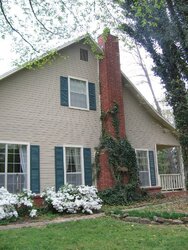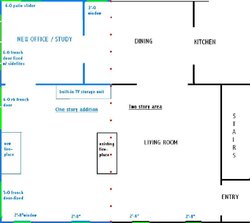Hey guys, I was looking for your thoughts on advantages/disadvantages on constructing a new chimney on the inside of the building envelope or on the outside. Attached is a photo of our existing brick chimney on the east end of our home. We are planning to build a one story addition on this side of the house so this chimney will need to be torn down. UGH! We will need to construct a new chimney on the addition.
Presently we are burning a Mendota wood hearth which was installed in 1992. This has been a great little unit and we are considering re-installing it in the new addition. I have been trying to find an excuse to purchase something like a Quadra-fire 7100 but my only complaint with the Mendota is the firebox is a little on the small side.
Anyhow, what I'm really wondering about is constructing an interior or exterior chimney. We would like to have floor to ceiling manufactured rock covering the chimney inside. Is there an advantage to constructing the outside wall chimney other than something that adds to the outside appearance?
Presently we are burning a Mendota wood hearth which was installed in 1992. This has been a great little unit and we are considering re-installing it in the new addition. I have been trying to find an excuse to purchase something like a Quadra-fire 7100 but my only complaint with the Mendota is the firebox is a little on the small side.
Anyhow, what I'm really wondering about is constructing an interior or exterior chimney. We would like to have floor to ceiling manufactured rock covering the chimney inside. Is there an advantage to constructing the outside wall chimney other than something that adds to the outside appearance?




